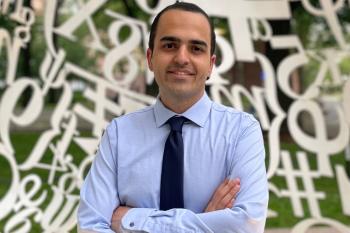When Mohammad Javad Khojasteh arrived at MIT’s Laboratory for Information and Decision Systems (LIDS) in 2020 to begin his postdoc appointment, he was introduced to an entirely new universe. The domain he knew best could be explained by “classical” physics that predicts the behavior of ordinary objects with near-perfect accuracy (think Newton’s three laws of motion). But this new universe was governed by bizarre laws that can produce unpredictable results while operating at scales typically smaller than an atom.
“The rules of quantum mechanics are counterintuitive and seem very strange when you first start to learn them,” Khojasteh says. “But the more you know, the clearer it becomes that the underlying logic is extremely elegant.”
As a member of Professor Moe Win’s lab, called the Wireless Information and Network Sciences Laboratory, or WINS Lab, Khojasteh’s job is to straddle both the classical and quantum realms, in order to improve state-of-the-art communication, sensing, and computational capabilities.
Growing up in Iran, Khojasteh knew he wanted to be a scientist from an early age. In high school, he became captivated by physics in particular. He was a first-generation college graduate, earning a dual bachelor’s degree in electrical engineering and math from Sharif University of Technology, before completing his PhD in electrical and computer engineering at University of California at San Diego (UCSD). There, he worked at the intersection of robotics and machine learning, developing tools to protect against cyber threats as well as learning-enabled planning algorithms for autonomous robots to operate safely in changing real-world scenarios. After graduating from UCSD in 2019, he remembers calling home to share the good news: “Mom, I’m officially a doctor now.”
After a stint at Caltech, where Khojasteh collaborated with NASA researchers to develop planning and control algorithms to improve off-road autonomous driving and build robots for life-detection missions on other planets, Khojasteh moved across the country to Cambridge, Massachusetts, to join LIDS and the WINS Lab.
“LIDS has always been at the center of the decision-making and information science field,” he says. “As an undergraduate, and later as a PhD student, I remember reading papers and textbooks by LIDS professors, so getting the chance to collaborate with these renowned researchers during my postdoc has been really exciting. LIDS is such an interesting and vibrant environment.”
Until this point, Khojasteh had focused primarily on classical systems such as autonomous vehicles, although he’d always maintained a keen interest in quantum systems. In the WINS Lab, he could finally focus on both pursuits in tandem.
There’s a quantum revolution on the horizon, he explains, that will transform the way devices perform sensing, computation, and communications tasks. Problems that take classical computers years to solve will be child’s play for the large-scale quantum computers slated to come online in the next few decades. For example, these new-wave quantum computers will allow biologists and chemists to better simulate molecular interactions to design new drugs — and even help engineers to design better batteries. These machines will also leverage the laws of quantum physics to advance medical research and clinical care.
In Khojasteh’s words: “This quantum revolution will change lives and help us to better understand the world around us.”
Because he was still so new to the field of quantum mechanics when he arrived in the WINS Lab, Khojasteh began by reading and discussing related papers with his lab mates to get up to speed. In the meantime, he started working on a project related to classical systems, helping robots to navigate while keeping their locations secret to thwart potential security breaches.
As Khojasteh began to master the rules of the quantum universe, he took on a second project that has since become his main endeavor, aimed at developing data-driven techniques to control the basic units of information that feed quantum computers.
While classical computers store information as electrical pulses that represent ones and zeroes called “bits,” quantum computers use quantum bits, or “qubits,” which might typically be subatomic particles. Based on their unique quantum mechanical properties, qubits can represent additional values besides just 0 or 1: They can also represent both 0 and 1 at the same time in different weights (a phenomenon known as superposition that can lead to computational advantages). However, because the dynamics of quantum systems are so difficult to predict, controlling the state of these qubits is no easy feat. While traditional approaches rely on manually designed models, Khojasteh’s method utilizes a hierarchical design that layers exploratory control, quantum tomography, Hamiltonian learning, and data-driven control techniques to more precisely tune the dynamics of these qubits, allowing quantum computers to operate more efficiently.
“I’ve learned so much from Professor Win,” Khojasteh says. “There are very few research groups with a foot in both classical and quantum physics, so working in his lab has been an amazing opportunity.”
With roughly a year left in his postdoc appointment, Khojasteh has begun considering his next career steps. He plans to apply to research scientist jobs in industry, as well as faculty positions. Becoming a professor would allow him to continue teaching, which he’s enjoyed immensely during his time at LIDS. In addition to serving as a teaching assistant, he has also volunteered for MIT’s Summer Research Program (MSRP), which empowers students from historically underrepresented groups in science to become researchers. Khojasteh mentored one MSRP student for over a year, and the two even co-authored a study together.
Whether he pursues a career in academia or industry, Khojasteh aims to continue performing fundamental research in quantum systems. His interdisciplinary background in physics, mathematics, engineering, robotics, machine learning, and quantum mechanics has endowed him with a multifaceted perspective, which he applies to every research problem he encounters.
“I’m somebody who enjoys crossing the imaginary boundaries between the fields and trying different methods to address a research question,” he says. “Everyone at LIDS also really values this interdisciplinary approach, which gives them a broad vision to conduct really interesting research and solve important problems.”



